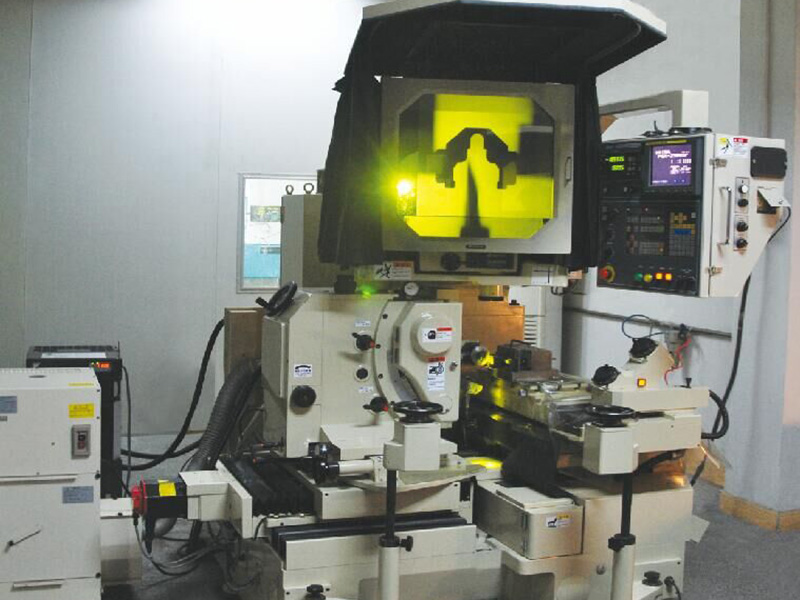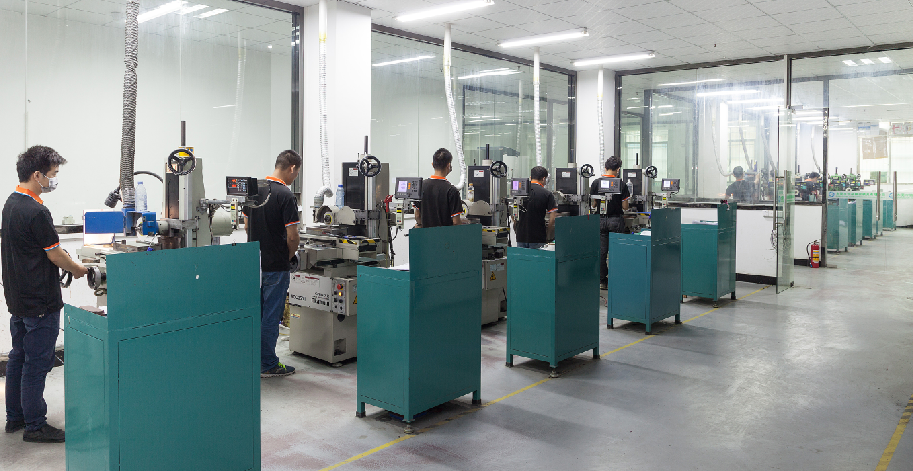Optical Profile Grinding Service / CNC Grinding Services
Optical Projection Grinding is a high-precision grinding process with a spindle speed of up to 30,000 RPM, a maximum vertical stroke of 110mm, and a maximum vertical stroke speed of 400 cycles/mm. This technology uses an optical projection system to project an enlarged profile of the workpiece onto a display screen. The operator controls the grinding head along a predetermined path based on the profile image on the screen. The tolerance is typically within 0.002mm, and some high-precision equipment can achieve ±0.001mm, with surface roughness reaching Ra0.05um. It is primarily used for processing high-hardness materials such as tungsten carbide or hard alloys, and also suitable for processing some high-speed steel components. It is commonly used for machining mold parts such as punch and die for connector molds, terminals, and precision semi-stroke punches.
Optical Grinding Technology Key Features and Advantages
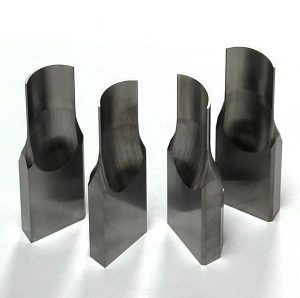
Features
1.High Precision Processing Capability: Tolerances can be controlled within ±0.002mm, with some equipment achieving precision up to ±0.001mm.
2.Optical Projection Assistance: The projection system magnifies and displays the workpiece profile on a screen, allowing the operator to visually compare it with the blueprint for precise and accurate processing.
3.Wide Range of Applicable Materials: Capable of processing high-hardness materials such as tungsten carbide, hard alloys, high-speed steel, as well as brittle materials like ceramics and semiconductors.
4.Automation and CNC Integration: Modern equipment is typically integrated with CNC systems, supporting programmed control of the grinding head’s path, improving processing efficiency and consistency.
Advantages
1.Precision Processing of Complex Shapes: This technology is especially suitable for processing complex contours (such as arcs, narrow grooves, irregular holes, etc.) and parts with intricate shapes, such as gears, punches, and mold components, ensuring high precision and consistency.
2.Excellent Surface Quality: The technology ensures that the processed parts have a surface roughness of up to Ra0.05μm. The low roughness reduces friction, wear, and stress concentration, enhancing the wear resistance and lifespan of the parts (such as die punches and precision components).
3.Efficiency and Flexibility: Compared to traditional grinding methods, this technology allows operators to precisely monitor the grinding process, ensuring that every step meets the required specifications, saving time and improving processing efficiency.
4.High Flexibility: Optical projection grinding is not only suitable for mass production but is also highly adaptable for prototype and custom needs, efficiently handling different sizes, shapes, and materials.
- Reduction of Errors and Waste: The precise optical projection technique reduces errors during the grinding process, avoiding production waste caused by angle deviations typical in traditional methods, ensuring high-precision mass production.
- Precise Adjustment and Control: Operators can view real-time results on the screen and make precise adjustments to the grinding head’s movement trajectory, ensuring that each part achieves optimal processing results.
Processing Steps for Optical Projection Grinding Parts
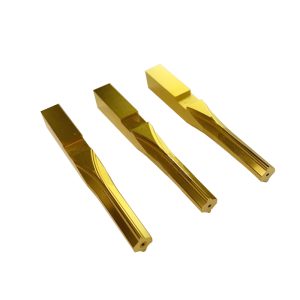
1.Workpiece Pre-treatment and Clamping
Cleaning: Use alcohol to remove oil, dust, and other impurities from the workpiece surface to avoid affecting processing accuracy.
Workpiece Clamping: Secure the workpiece using a vacuum suction cup, magnetic fixture, or precision mechanical clamp to prevent displacement during grinding.
Coordinate System Calibration: Align the workpiece coordinate system with the machine tool coordinate system using optical projection or contact probes to determine the processing reference.
2.Optical Projection and Parameter Setup
Graphical Import: Use the optical projection system to project the workpiece profile onto a display screen, typically with a magnification factor of 50-200 times.
Parameter Configuration: Set grinding spindle speed, feed rate, fine grinding, and grinding pressure according to the workpiece material and precision requirements.
3.Rough Grinding
Material Removal: Use a larger feed rate for rapid grinding to remove 80%-90% of the total material, forming the basic contour shape.
Precision Control: Control the surface roughness to Ra1-2μm, with flatness or contour errors ≤ 5μm, leaving an even processing allowance for fine grinding.
4.Fine Grinding
Precision Grinding: Switch to finer grain grinding wheels (such as diamond micro-powder wheels), reduce the feed rate, and perform fine grinding on the workpiece surface.
Real-Time Monitoring: Use laser interferometers, optical encoders, and other measurement systems to provide real-time feedback on grinding depth and position, with closed-loop control to compensate for wheel wear and thermal deformation, ensuring surface roughness reaches Ra0.1μm or below, and flatness error ≤ 0.5μm.
5.Surface Polishing (Optional)
High-Precision Demand: For applications like optical components and semiconductor wafers, use magnetorheological polishing, ion beam polishing, or chemical mechanical polishing (CMP) to further reduce surface roughness to Ra0.01μm and eliminate subsurface damage.
6.Quality Inspection and Post-Treatment
Precision Verification: Use high-precision measuring instruments such as CMMs (coordinate measuring machines), height gauges, and projectors to verify dimensional and geometric tolerances, and use a microscope to check for surface defects (such as scratches or chipping).
Cleaning and Treatment: Clean the workpiece with alcohol to ensure it is free of contaminants and impurities.
7.Delivery and Packaging
Quality Inspection Report: After the workpiece is finished, provide a detailed quality inspection report, including surface roughness, dimensional tolerances, and other key information to ensure the customer fully understands the quality of the workpiece.
Packaging and Delivery: Package the workpiece appropriately to prevent damage during transportation, ensuring safe delivery to the customer.
Why choose our optical projection grinding processing
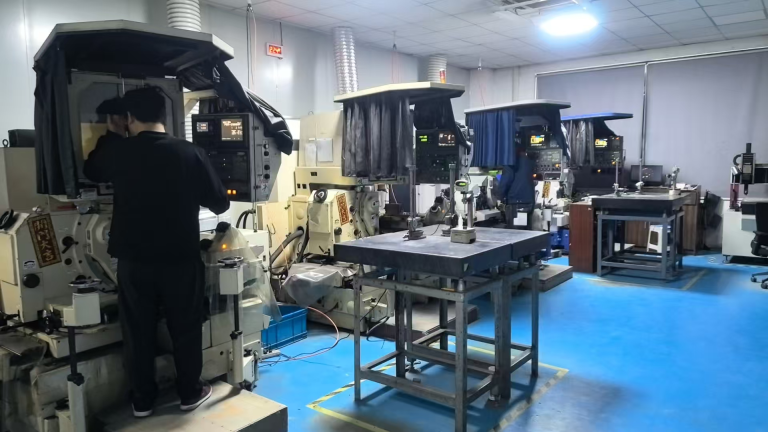
1.Outstanding Processing Precision
Our optical projection grinding technology provides extremely high processing precision, with tolerances as low as ±0.001mm and surface roughness as fine as Ra0.05μm, ensuring that your parts meet the highest quality standards.
2.Capability to Handle Complex Structures
Through the integration of optical projection and CNC technology, we efficiently complete precision grinding of freeform surfaces, small apertures (≤0.1mm), and irregular contours, overcoming challenges that traditional processes struggle with. We can precisely process complex shapes and fine details, making it suitable for various intricate workpieces, such as aspherical lenses, precision molds, and tiny electronic components, all while meeting high demands for complex geometries.
3.Strict Quality Control
International Standard Certification: Following the ISO 9001 quality management system, we incorporate advanced measurement equipment such as Mitutoyo profile meters, Zeiss CMMs, and NIKON projectors for 100% inspection at every stage to ensure zero-defect delivery.
Customized Process Solutions: Based on different materials (glass, ceramics, silicon wafers, etc.) and application scenarios, we offer tailored grinding parameter optimization and process design to ensure stability and consistency in processing.
4.Efficient Delivery, Cost Control
Quick Response Mechanism: With multiple high-precision grinding machines and a professional team, we support 48-hour delivery for small batch samples and reduce production cycle times by 30% for large orders, accelerating customer product launch.
Cost-Performance Advantage: By optimizing production through automation and process improvements, we reduce unit processing costs, saving customers 5%-10% in total costs while ensuring quality.
5.Industry Expertise and Extensive Experience
We have accumulated extensive experience in processing complex parts across various industries, including precision lens surface grinding and semiconductor wafer thinning, covering optical, semiconductor, precision machinery, and medical device fields, with strong customer satisfaction.
Technology R&D Strength: Collaborating with universities and research institutions, we continuously invest in the development of micro-nano processing technologies, mastering cutting-edge industry processes to provide customers with forward-thinking solutions.
6.One-Stop Service, Hassle-Free Cooperation
Full-Cycle Service Support: From design and prototype sampling to mass production and after-sales maintenance, we provide a one-stop service with dedicated technical consultants who respond to your needs in real-time.
Flexible Cooperation Models: Supporting customized processing and long-term strategic partnerships, we can flexibly adapt to your diverse business needs.
Which fields are optical projection grinding parts applied to?
Optical projection grinding parts, with their high precision and ability to process complex structures, play a key role in several industries that require stringent precision for components. The main application fields are as follows:
- Optical and Optoelectronic Industry
Optical component processing: Used for grinding curved and flat surfaces of components such as lenses, prisms, filters, and optical windows to ensure imaging clarity (e.g., aspherical grinding for camera lenses).
Optical communication devices: Machining fiber optic connector endfaces, optical waveguide substrates, etc., ensuring low loss and stability in optical signal transmission.
- Semiconductor and Electronics Manufacturing
Semiconductor wafer processing: Grinding silicon wafers and compound semiconductor wafers to achieve nanometer-level flatness, meeting photolithography requirements in chip manufacturing.
Integrated circuit packaging: High-precision planar grinding of packaging substrates and lead frames to ensure reliable connections between chips and packaging structures.
Precision electronic components: Processing complex contours of tiny components such as mobile phone camera module lens brackets and sensor housings.
- Precision Machinery and Instrumentation
Precision mold manufacturing: Grinding cavities and cores of injection molds and stamping molds, especially complex curved molds (e.g., automotive lighting molds), improving product molding accuracy.
Instrument parts: Machining gears for clocks, gyroscope frames, flow meter valve cores, ensuring precise mechanical coupling.
Aerospace components: Grinding precision bearings, sensor housings, etc., for aerospace instruments, meeting reliability requirements in extreme environments.
- Medical and Biotechnology
Medical device parts: Grinding endoscope lens assemblies, surgical instrument tips, dental implant bases, ensuring surface smoothness and dimensional precision (e.g., curved surface grinding for orthopedic implants).
Biological chips and detection devices: Grinding microfluidic chip substrates, biosensor bases, achieving micron-level channel and structure processing.
- New Energy and Environmental Protection
Solar cell manufacturing: Grinding silicon wafer surfaces to optimize light absorption efficiency or machining precision components in photovoltaic modules.
Fuel cell components: Grinding flow channels in proton exchange membrane fuel cells, ensuring uniform gas transmission and electrochemical reaction.
- Research and Micro-Nano Processing
Micro-nano structure research: Used by universities and research institutions to process MEMS (Micro-Electro-Mechanical Systems) devices, nano-imprint molds, etc., supporting micro-nano scale scientific experiments.
New material processing: Grinding complex microstructures on hard and brittle materials such as ceramics, sapphire, and silicon carbide (e.g., semiconductor substrate material processing).
- Consumer Electronics and High-End Manufacturing
3C product components: Machining components like mobile phone frames, camera lens brackets, and high-end watch cases, balancing appearance accuracy and functionality.
Automotive precision parts: Grinding automotive sensor housings, fuel injector valve cores, lidar optical components, improving the reliability of driving systems.
Advantages and Disadvantages of Optical Projection Grinding
| Feature | Optical Projection Grinding Machine | Traditional Grinding Machine |
| High precision | precision: ±0.001mm, Surface roughness: Ra0.05μm | Micron-level precision, suitable for mechanical dimensional requirements |
| Complex shape machining | Capable of machining complex geometries, such as aspheres and irregular contours | Not suitable for complex geometries, can only machine regular shapes like planes |
| Machining efficiency | Highly automated to reduce manual intervention and shorten production cycles | Higher efficiency in mass production, especially for products with low precision requirements |
| Real-time monitoring and adjustment | Real-time feedback with automatic compensation for grinding wheel wear and thermal deformation | Requires manual adjustment and more human intervention |
| Suitable materials | Suitable for hard and brittle materials (tungsten steel, cemented carbide, ceramics, silicon wafers, sapphire) and metals | Mainly targets metallic materials such as steel and iron |
| Equipment cost | High initial equipment investment requiring high-precision maintenance | Lower equipment and maintenance costs |
| Degree of automation | Integrated CNC system for automatic programming | Manual feeding, relying on experience, low efficiency |
| Suitability for mass production | Best suited for small-batch, high-precision or customized production | Suitable for mass production scenarios with low precision requirements |
| Application scenarios | Application in optical lenses, semiconductor wafers, precision instruments, optical communication devices, aerospace components, etc. | Mechanical parts, metal components |
| Fixturing and positioning | Vacuum chucks/magnetic fixtures | Mechanical fixtures (e.g., vise) |
| Core advantages | Core advantages: High precision, high automation, strong capability in complex structure machining | Core advantages: Low cost, flexible operation, suitable for simple shape machining |
| Core disadvantages | Core disadvantages: High equipment and maintenance costs, limited efficiency in high-precision machining | Core disadvantages: Poor automation, weak capability in complex structure machining |
FAQ
What types of workpieces can optical projection grinding process?
Optical projection grinding technology can process a wide range of high-precision workpieces, especially those with complex geometries, small dimensional requirements, and high surface quality demands. Below are some common types of workpieces that optical projection grinding can process:
- Precision Mold Parts
- Cutting Tools and Tooling
- Optical Components and Precision Parts
- Electronic and Semiconductor Components
- Aerospace and Medical Devices
- Tungsten Carbide / Ceramics
Models of Optical Projection Grinding Machines:
- WAIDA SPG-X
- Rollomatic ShapeSmart® NP5
- Okamoto ACC-12-24SA
- Klingelnberg HÖFLER
- Toyoda GL4i
- SCHAUDT/MIKROSA KGM
- Chevalier FSG-3A/4A
How to Choose the Right Optical Projection Grinding Service Provider?
- Technical Expertise and Experience
- Equipment Models and Precision
- Quality Control and Certification
- Delivery Capability and Response Speed
- Customer Reputation and Case Studies
- Price and Cost-effectiveness
- After-sales Support
What Materials Can Optical Projection Grinding Process?
Optical projection grinding technology can process a variety of materials. Below are some common materials that can be processed using optical projection grinding:ungsten Carbide (Hard Metals), Ceramics, Silicon Wafers and Semiconductor Materials, Sapphire, etc.
Try JUNYU Out Now In Just A Few Steps
Upload your 2D/3D files
Simply upload your project files—our engineering team will review them and deliver a customized solution promptly.
Your Order Get Started
As long as we receive your confirmation, we will start your project immediately.
Receive Your Order
Your custom machined parts will be delivered right to your doorstep.
Ready to place your order? Fill out the form below to get in touch with us!

